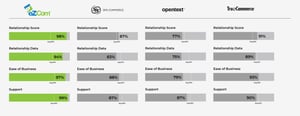Every Supplier Should Know
If you want to keep up with the always changing retail landscape, you can’t be light on the lingo. (Pun intended. You don’t want to be light on our Lingo software either.) As retailers search for ways to stay relevant and drive sales, new terminology emerges.
It’s not all new, of course. Some retail terms have been around for years — anchor stores, Point-of-Sale and, yes, EDI — but there is a lot that’s come forward in recent years.
So no matter where you are as supplier — a newcomer or a savvy veteran — take a look at this list. At the very least, you could pick up a new term to drop on your next sales call.
Anchor Store to Drop Shipping
1. Anchor Store
One of the largest—if not the largest—store in a mall or shopping center, typically a famous department store or retail chain. For small and medium retailers, anchors have usually been good neighbors. But as shopping habits change, some anchor stores are struggling and many malls are figuring out how to replace the traffic they have produced in the past.
2. Big Box Store
Straightforward enough — a big box store is a large store, usually part of a major retail chain. Think Target, Best Buy, Home Depot.
3. Brick-and-Click
A buzzword that indicates a traditional brick-and-mortar store has also been able to build a powerful eCommerce operation. The best retailers make things seamless by letting consumers make returns in stores or pick up merchandise at a physical location.
4. Click-and-Collect
Click-and-collect lets shoppers buy online and pick up the items in a physical store. It’s popular because it lets people save on shipping costs and get their purchase at a time that’s convenient for them. Some also appreciate the security aspect — their purchases won’t be sitting outside their front door until they return home.
5. Drop Shipping
Instead of keeping products in its own inventory, the retailer sends orders and shipment information to the supplier, and the supplier fulfills the order. One catch: most retailers want this to be invisible to consumers and will require you to send the product with the appropriate branding and labels.
EDI, Etailing, and More
6. Dynamic Clustering
Dynamic Clustering identifies patterns or opportunities in various and diverse segments, often regionally based. Retailers will then approach each cluster with a specific strategy. It doesn’t matter if a store sells apparel or tools or electronics, chances are they’ll want a different merchandise mix in California than, say, Nebraska. When retailers are focused on dynamic clustering, suppliers need to have a system in place so they can respond to requests quickly and efficiently.
7. Etailing
When you sell something online, it’s etailing. Of course, everyone does it now and suppliers have to be on top of it all — online marketplaces like Amazon, eCommerce stores powered by companies like Shopify or Magento, and traditional brick-and-mortar retailers with powerful web brands of their own.
8. EDI
It’s Electronic Data Interchange, and it’s a data format that still dominates among major retailers. It’s not uncomplicated but it’s necessary to do business with many stores. The good news is that we’re pros — we’ve been providing EDI services since 2000.
9. EPOS
It’s short for Electronic Point-of -Sale. At its most basic, it includes any computer-driven system that records sales and controls inventory.
10. Flash Sales
These are sale events that take place for a limited time. Very limited, so it’s not something like the Big September Sale. Often just a few hours and sometimes a couple of days, they are especially popular with Internet retailers. Zulily is a major flash sale web site. You’ll want to evaluate the pros and cons before you put your products into these sales.
Supply Chain, Omnichannel and More
11. Green Retailing
Many stores are adopting environmentally-friendly practices and, as a supplier, you may be asked to do anything from ship differently to change the packaging if you want to have your product in a store.
12. Integrated Supply Chain
EDI and order management are key elements of this network of businesses and contractors that work together to manufacture, transport, distribute, and sell retail goods. When a supply chain is truly integrated — and we have an Integration team — data flows easily and goods move quickly.
13. Keystone Pricing
Many retailers will use this formula. They sell at double the wholesale price for two reasons — it’s simple and it usually covers cost while providing sound profits. It’s really KISS — Keep It Simple, Stupid.
14. Mobile Shopping
Thanks to smartphones and tablets, people are buying nearly all the time, no matter where they are in the world. It’s online shopping with smaller screens.
15. Omnichannel
Oh, you’ll hear this one plenty. If you’re a supplier, you want to sell in many locations. If you’re talking about omnichannel, your products are in stores, online, in catalogs, in pop-up stores — basically anywhere that makes sense for your brand. The challenge is making sure you have a system in place to manage it all and bring all the information together.
16. Pop-Up Store
As noted in the previous entry, these are short-term shops or sales spaces. It’s a great way to float a new product idea, generate sales or even serve as an ad that people can touch and feel.
17. Product Life Cycle
The stages that each product goes through once it hits the market. They include introduction, growth in sales revenue, maturity, and decline. Obviously, decline isn’t great. But if you’re a trend-focused supplier, being aware of product life cycles will help you determine when to launch something new or boost an item you already have.
18. Social Commerce
When retail models rely heavily on social media, user-generated content, or social interaction, they are considered social commerce. They’re not where people buy or sell but they do drive purchases. It could include anything from Twitter or Instagram to Kickstarter and GoTryItOn.
Mashable provides a great rundown of the types of Social Commerce on the web.
19. Unified Brand Experience
Retailers strive to create consistent brand or identity across all platforms and channels, including brick-and-mortar, ecommerce, or mobile. If you’re a supplier, and doing something like drop ship, ensuring this happens will become one of your responsibilities.
20. Webrooming
When shoppers look at something online before making a purchase at a physical location, it’s called webrooming. As a supplier, it’s important that the retailer presents your products well online. Check the retailer sites regularly, and offer to share digital assets like photography if it will benefit your sales numbers.







